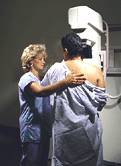
THURSDAY, March 22 (HealthDay News) — Breast cancer is more likely to recur in women over 50 who have denser breast tissue, researchers report, noting that doctors should take breast density into account when making initial treatment decisions.
The Swedish study found that women with denser breasts had nearly twice the risk of recurrence, either in the same breast or in the surrounding lymph nodes, than women with less dense breasts.
“We found that if you have a PD [percentage density] at diagnosis of 25 percent or more, you have an almost twofold increased risk of local recurrence in the breast and surrounding lymph nodes than women with a PD of less than 25 percent,” said Dr. Louise Eriksson and colleagues from the Karolinska Institute in Stockholm.
“However, density does not increase the risk of distant metastasis [spread] and has no effect on survival,” Eriksson said.
Breast density, which can be determined through mammography, varies among women and decreases with age, especially at menopause, the researchers noted.
For the study, the researchers reviewed mammograms and treatment results for almost 1,800 postmenopausal women, aged 50 to 74, who were part of a larger study of women diagnosed with breast cancer in Sweden between 1993 and 1995.
The findings were presented Wednesday at the European Breast Cancer Conference, in Vienna.
It is known that dense breast tissue increases the odds of developing cancer, but whether breast density might influence recurrence has not been established.
“Our study shows that breast density before or at diagnosis should be taken into account even after diagnosis, for instance, when deciding on adjuvant [secondary] treatment and follow-up routines,” Eriksson said in a meeting news release. “Perhaps women with dense breasts should be followed more frequently or for a longer period of time in order to quickly spot any local recurrence.”
The research showed that breast density differs greatly. “In the group of women I studied, those with the lowest percentage density had breasts that were less than 1 percent dense, whereas those with highest PD had 75 to 80 percent dense breasts,” Eriksson said. The average was 18 percent, she noted.
She said the findings are significant because of the detailed information on each woman and the overall size of the study. “This is one of the largest studies to date studying mammographic density, tumor characteristics and prognosis,” Eriksson said in the news release.
Why dense breasts influence cancer is still unclear, and researchers say more work is needed before the findings could influence medical practice.
David Cameron, a professor at the University of Edinburgh in Scotland, said in the news release that the study is more thought-provoking than practice-changing, “since it is not clear what a patient, or her physician, should do if the mammogram shows a higher density of the normal breast tissue.”
Research presented at meetings is considered preliminary until published in a peer-reviewed medical journal.
More information
The U.S. National Library of Medicine has more about breast cancer.

